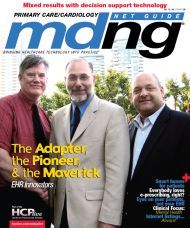The Smart Home
As we age, the limitations on where we live and how we can live increase.
As we age, the limitations on where we live and how we can live increase. Yet, rarely do we really want to move out of our homes; it is disruptive, expensive, uncomfortable, and usually includes some loss of independence. Therefore, it is important that physicians be able to advise patients and their families on how to stay at home longer, preserve function, and optimize success. Smart homes are designed for simplicity and success. They can eliminate the need for occupants to devote time and energy to many tasks of everyday living. Smart homes turn on the lights when we enter a room; they set off alarms if the temperature drops below a critical point; furnaces adjust to our habits and behaviors and “learn” to adjust the temperatures in expectation of where we will be at any point in time during a regular day. Let’s tour some rooms of a smart house to see what’s already available.(Click image to the right to view a larger spread.)1 Car
Clearly, the smartest device you own is your automobile. Late model cars come with a number of safety features, and the one that I routinely recommend to my older patients is OnStar. Elderly patients’ ability to process information after getting in an accident is further compromised by their uncertainty, the unfamiliarity of the surroundings, and the anxiety-provoking situation itself.
2 Garage
Garage door openers have security codes and work at rotating frequencies to prevent break-ins and random openings or closings. Lights go on and off automatically, either when the door is opened or when the car approaches, and a motion detector hooked to the external lighting senses activity. Even more importantly, a closing garage door will not injure a bystander; not only will it with pressure, but light beam sensors six to nine inches off the ground are always on guard, and when obstructed, reverse power.
3 Entrance Entrances should have barrier-free access and no steps. Alarm systems should serve a variety of functions. Home monitors should protect the home and protect the individuals within. Smoke alarms, temperature sensors, and motion detectors can all be used to the full advantage of the occupant.
4 Bedroom
Older persons have poorer vision and more gait disturbance and are up more frequently during the night for a variety of reasons. Motion detectors that turn on lights automatically and night-lights add sensory input to help navigate even familiar surroundings. Carbon monoxide detectors should be placed in bedrooms. For those who are hard of hearing, alarms can be placed under the mattress or pillow that have such powerful vibrations that they can shake you out of bed. Load sensors can be placed under the beds to determine an average daily weight and report it back to a computer system for ongoing monitoring.
5 Bathroom Grab bars, non-slip flooring, and electronic pill dispensers offer great support. Walkin showers may be the safest option for bathing, especially when soap is in a dispenser around elbow level. The Japanese have also designed a variety of sensors for the toilet (see the gadget guide in the October issue of MDNG).
6 Laundry Main floor laundries eliminate the need for the dangerous trek to the basement on unprotected wooden stairs. Even better, laundry areas on the second fl oor of twostory dwellings make good ergonomic sense and also add an additional level of safety by eliminating the need to carry full laundry baskets up and down stairs.
7 Furnace and Water Heater It is hard to scald yourself with today’s water heaters, as temperature maximum is well regulated. Carbon monoxide detectors and other “lock-out” devices will also shut down a furnace when problems exist and will let you know something is wrong. Heating and cooling throughout the house will “learn” behaviors and adjust to a general pattern of activity.
8 Kitchen An opener by Black & Decker can unscrew just about any bottle or jar. Microwave ovens are, for the most part, safer than gas fl ame, and new induction cooktops heat the metal pot but do not heat the surface or your hand if you inadvertently place it on the heating element.
9 Living and Family Room Lighting and floor covering are essential to a safe home. As we age, depth perception and visual acuity worsens. We need good lights and strong defi nitions to walls, fl oors, and edges, particularly stairs. Sharp color contrast and railings are the order of the day. Light bulbs and tubes (especially fl uorescent) now come in a wide spectrum of colors, giving us greater opportunity for rooms to be both comfortable and well lit.
